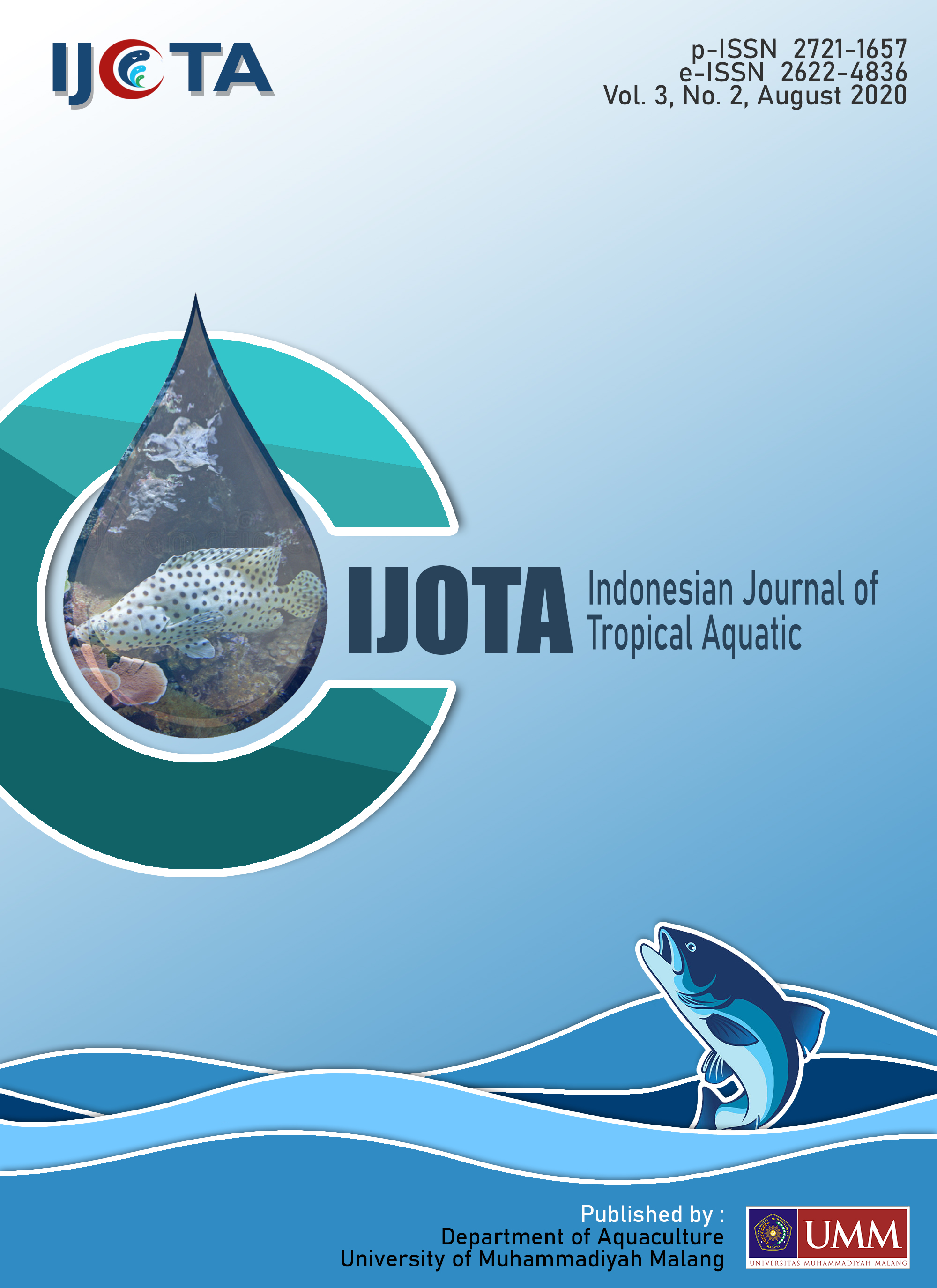Analysis of Snakehead Fish (Channa striata) Cultivation Business in Peatland, Dadahup Village, Kapuas Regency, Indonesia
DOI:
https://doi.org/10.22219/ijota.v3i2.13409Keywords:
Break even point, Catfish, R/C ratio, Total costAbstract
Snakehead fish (Channa striata) is a popular freshwater commodity with high market demand in Indonesia, especially in Central Kalimantan. Kapuas Regency, there is a group of farmers who utilize the productivity of peatland to be used as a medium of cultivation of snakehead fish through a biological approach. This research aims to analyze the efforts of members of the fish cultivation group Bahtera Handal Dadahup (BHD), Kapuas Regency based on business analyze to determine the net profit value (π), R/C ratio, Payback Period (PP), and Break Even Point (BEP). BHD group obtained a value ranging from Rp 11 935 000 to Rp 46 022 500; R/C > 1, i.e. ranging from 2.96 to 4.29. Payback Period or return period of capital (investment) lasts for 5 to 10 months; and break even point (BEP) values range from Rp 9 318.3 kg-1 to Rp 13 477.7 kg-1. Based on the calculation of the analysis of the business, the business of fish cultivation group Bahtera Handal Dadahup, deserves to be run and developed.Downloads
References
FAO. 2008. Species Fact Sheet: Channa striata (Bloch, 1793). FAO Fisheries & Aquaculture. http://www.fao.org/fishery/ species. Serial online 2000—2008. 2 pp.
Fitriadi F, Nurmalina R. 2008. Analisis Pendapatan dan Pemasaran Padi Organik Metode System of Rice Intensification (SRI) : Kasus di Desa Sukagalih, Kecamatan Sukaratu, Kabupaten Tasikmalaya. Jurnal Pengkajian dan Pengembangan Teknologi Pertanian. 11 (1): 94–103.
Hariance R, Annisa N, Budiman C. 2018. Kelayakan Finansial Agroindustri Olahan Pepaya (Carica papaya L.) Di Nagari Batu Kalang Kecamatan Padang Sago Kabupaten Padang Pariaman. Jurnal AGRIFO. 3(1): 1–9.
Heptarina D. 2018. Gabus Si Penyumbang Inflasi Sumatera Selatan. Balai Riset Perikanan Budidaya Air Tawar dan Penyuluhan Perikanan. Jurnal riset budidaya perairan. 6(2): 12–19.
Huwoyon GH, Gustiano R. 2013. Peningkatan Produktivitas Budidaya Ikan di Lahan Gambut. Media Akuakultur. 8(1): 22–28.
Listyanto N, Andriyanto S. 2009. Ikan Gabus (Channa striata) Manfaat Pengembangan dan Alternatif Teknik Budidayanya. Media Akuakultur. 4(1): 18–25.
Lumintang FM. 2013. Analisis Pendapatan Petani Padi di Desa Teep Kecamatan Langowan Timur. Jurnal EMBA. 1(3): 991–998.
Mamodol MR. 2016. Analisis Kelayakan Ekonomi Usahatani Padi Sawah Di Kecamatan Pamona Puselemba. Jurnal Envira. 1(2): 1–10.
Masganti. 2003. Kajian Upaya Meningkatkan Daya Penyediaan Fosfat dalam Gambut Oligotrofik. Disertasi. Program Pascasarjana UGM, Yogyakarta.
Masganti, Anwar K, Susanti MA. 2017. Potensi dan Pemanfaatan Lahan Gambut Dangkal untuk Pertanian. Jurnal Sumberdaya Lahan. 11(1): 43–52.
Nazir M. 2005. Metode Penelitian. Jakarta: Ghalia Indonesia.
Normansyah D, Rochaeni S, Humaerah AD. 2014. Analisis Pendapatan Usahatani Sayuran Di Kelompok Tani Jaya, Desa Ciaruteun Ilir, Kecamatan Cibungbulang, Kabupaten Bogor. Jurnal Agribisnis. 8(1): 29–44.
Rachadian FR, Agassi EA, Wahyudi S. 2013. Analisis Kelayakan Investasi Penambahan Mesin Frais Baru Pada Cv. Xyz. Journal J@TI Undip. 8(1): 16–22.
Soekartawi. 2006. Analisis Usaha Tani. Jakarta: UI Press.
Sofian, Anwar S, Saputra M. 2019. Kinerja Pertumbuhan Ikan Gabus (Channa striata) dengan Suplementasi Astaxanthin pada Level Berbeda. Jurnal Akuakultur Rawa Indonesia. 7(2): 77–85.Downloads
Published
How to Cite
Issue
Section
License
Copyright (c) 2020 Muhammad Faiq Naufal

This work is licensed under a Creative Commons Attribution-ShareAlike 4.0 International License.
IJOTA (Indonesian Journal of Tropical Aquatic) allows readers to read, download, copy, distribute, print, search, or link to its articles' full texts and allows readers to use them for any other lawful purpose. The journal allows the author(s) to hold the copyright without restrictions. Finally, the journal allows the author(s) to retain publishing rights without restrictions
- Authors are allowed to archive their submitted article in an open access repository
- Authors are allowed to archive the final published article in an open access repository with an acknowledgment of its initial publication in this journal


